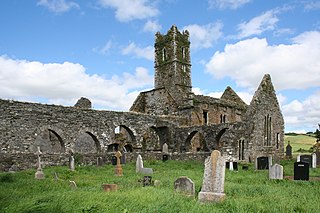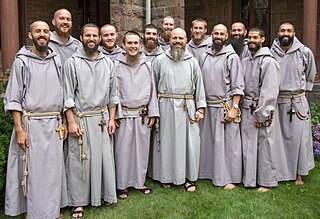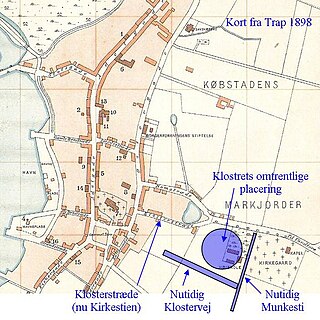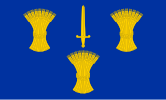Related Research Articles

Timoleague Friary, also known as Timoleague Abbey, is a ruined medieval Franciscan friary in Timoleague, County Cork, Ireland, on the banks of the Argideen River overlooking Courtmacsherry Bay. It was built on the site of an early Christian monastic site founded by Saint Molaga, from whom the town of Timoleague derives its name. The present remains date from roughly the turn of the fourteenth century and were burnt down by British forces in the mid-seventeenth century, at which point it was an important ecclesiastical centre that engaged in significant trade with Spain.

Agnellus of Pisa, OFM, was an Italian Franciscan friar. As the order's first minister provincial in England (1224–1236), he is considered the founder of the Franciscans in England. His feast day is variously observed in the Catholic Church, on 7 May or 10 September.

The Franciscan Friars of the Renewal is a Catholic clerical religious congregation of Pontifical Right for men founded in 1987. It follows the Capuchin Franciscan tradition.
Events from the year 1540 in Ireland.
Ralph of Maidstone was a medieval Bishop of Hereford.

Nysted Friary, located in Nysted, on the island of Lolland in southern Denmark, now in Guldborgsund municipality in Region Sjælland, was the last occupied Franciscan friary in Denmark after the Reformation.
Chester Carmelite Friary, otherwise Chester Whitefriars, was a friary in the city of Chester in Cheshire, England. The Carmelites were present in Chester from the late 1270s and by the mid-14th century were established as a well-regarded community. Their church and graveyard were popular for burials of the well-to-do and the friary was often mentioned in Chester wills. Their church steeple when rebuilt in 1495 became a useful landmark for ships. The friary was dissolved in 1538. There are no surviving buildings but the street name Whitefriars preserves the memory of the community.
Greyfriars Nottingham was a Franciscan friary in Nottinghamshire, England. It was founded c. 1224–1230, and dissolved in 1539 as part of King Henry VIII's Dissolution of the Monasteries. The site of the friary is now occupied by the Broadmarsh Shopping Centre.
Stafford Friary was a religious house of Franciscan friars in Stafford, Staffordshire, England. Founded sometime in the 13th century, it was a surrendered to the Crown in 1538, during the Dissolution of the Monasteries.

The Franciscan Friary and the Church of Saint Anthony of Padua, an architectural ensemble consisting of the Franciscan friary of Saint Anthony on Bistrik and the Church of Saint Anthony of Padua, is a Roman Catholic place of worship and one of the houses of Franjevačka provincija Bosna Srebrena. It is dedicated to the Franciscan friar Anthony of Padua. The complex of buildings is inscribed into the list of National Monuments of Bosnia and Herzegovina by the KONS. The friary and church are located in Sarajevo, in the Stari Grad municipality, Bosnia and Herzegovina.
Newark Friary, also known as Newark Greyfriars and Newark Observant Friary, was a friary of the reformed "Observant Friars" of the Franciscan Order, located in the town of Newark, Nottinghamshire, England. The friary as founded by Henry VII around 1499, and dissolved by his son Henry VIII in 1539.

St Augustine's Abbey or Chilworth Abbey, formerly Chilworth Friary, is a Roman Catholic Benedictine abbey in Chilworth, Surrey. The building, which is Grade II listed, was designed by Frederick Walters and was built in 1892. It was formerly a Franciscan friary and a novitiate for the order. The abbey church is open to the public 365 days a year.
The Franciscan Friars of Killarney is a 1911 American silent documentary produced by Kalem Company. It was directed by Sidney Olcott.
Events from the year 1448 in Ireland.

The Friary Community Hospital is a health facility in Queen's Road, Richmond, North Yorkshire, England. It is managed by South Tees Hospitals NHS Foundation Trust. The main frontage, facing east, is 19th century, while the adjacent block, facing south, is 18th century and is a Grade II listed building.

Robert Joseph Lombardo C.F.R. is an American Catholic prelate who has served as auxiliary bishop for the Archdiocese of Chicago since 2020.
References
- ↑ "Chester - Today". Franciscan Friary, 15 Cuppin Street, Chester CH1 2BN. Archived from the original on 11 September 2011. Retrieved 1 September 2010.
- ↑ "Friaries: The Franciscans of Chester". A History of the County of Chester. 3: 171–173. 1980. Retrieved 1 September 2010.
